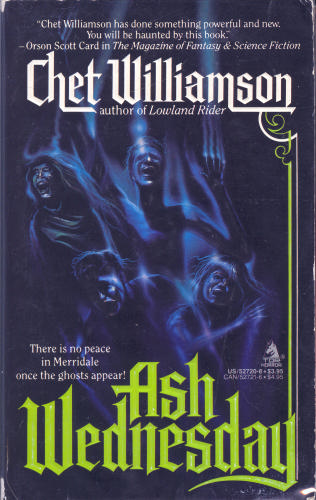Ash Wednesday (Tor Books, 1987).
This was my second novel, published by Tor Books in hardcover and then in paperback.
It was an attempt at a “passive” horror novel, in which people in a small town (modeled after my own Elizabethtown) wake up one morning to discover that the dead are now visible as naked, semi-transparent blue forms, in the position that they were at the moment of death. They don’t move, they don’t speak; they are merely grim reminders of mortality. The action of the novel stems purely from the townspeople’s reactions to these ghosts. The plot also bears numerous parallels to Conrad’s Lord Jim.
The book was a final nominee for the 1988 Horror Writers of America’s Stoker Award. In The Magazine of Fantasy & Science Fiction, Orson Scott Card wrote, “Chet Williamson has done something powerful and new. You will be haunted by this book.” Library Journal: “a fine psychological thriller…and a richly textured and satisfying novel.” Fantasy Review: “a rich, carefully constructed novel about the ravages of guilt and about the real horror of life.” Rave Reviews: “a riveting, descriptive account of the effect the dead have on the living…both thought-provoking and entertaining.”
Fritz Leiber, who was one of my literary idols as I grew up, wrote: “By following the science-fiction precept of examining realistically and carefully the results of a single change in the circumstances of existence, Williamson has built a strong if necessarily macabre and uncomfortable tale of moral import.”
The novel has received a separate entry in the three-volume Supernatural Literature of the World, which declared it imbued “with a poignancy most horror novels only hope to achieve.”
An interesting footnote is that the final chapter was removed by editorial suggestion, and printed for the first time in Issue # 9 of Bill Munster’s magazine, Footsteps, in 1990.
One more item of interest is that the first dust jackets printed were embossed, but the name of the author was misspelled “Chet Willimson” everywhere on the jacket. The corrected jacket bore no embossing. I donated a copy of the book with the first state, never released dust jacket to an HWA auction, where it sold for over $300.
The book is now out of print, but is easily found in the used book markets. As for the first state jacket, not so much…










